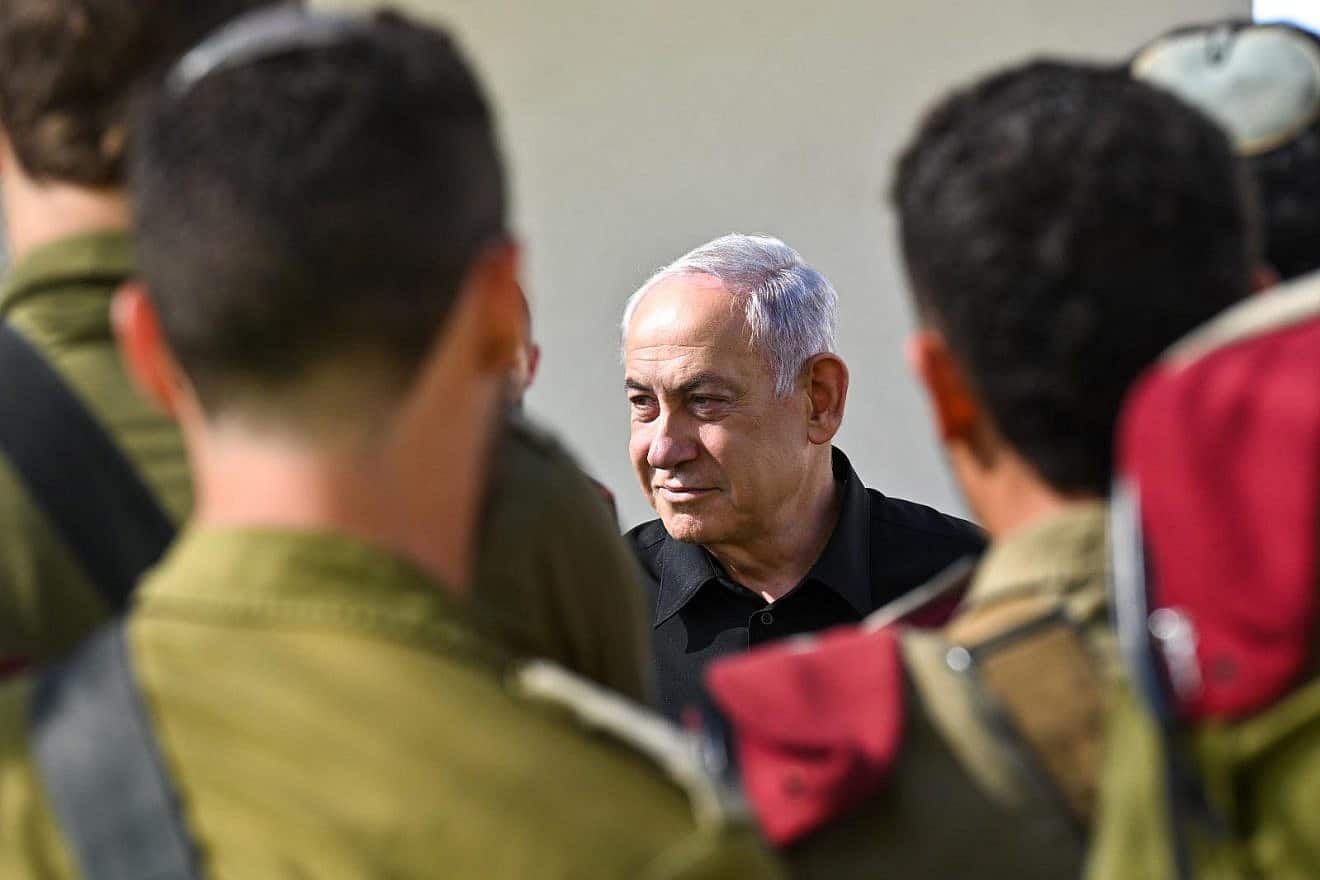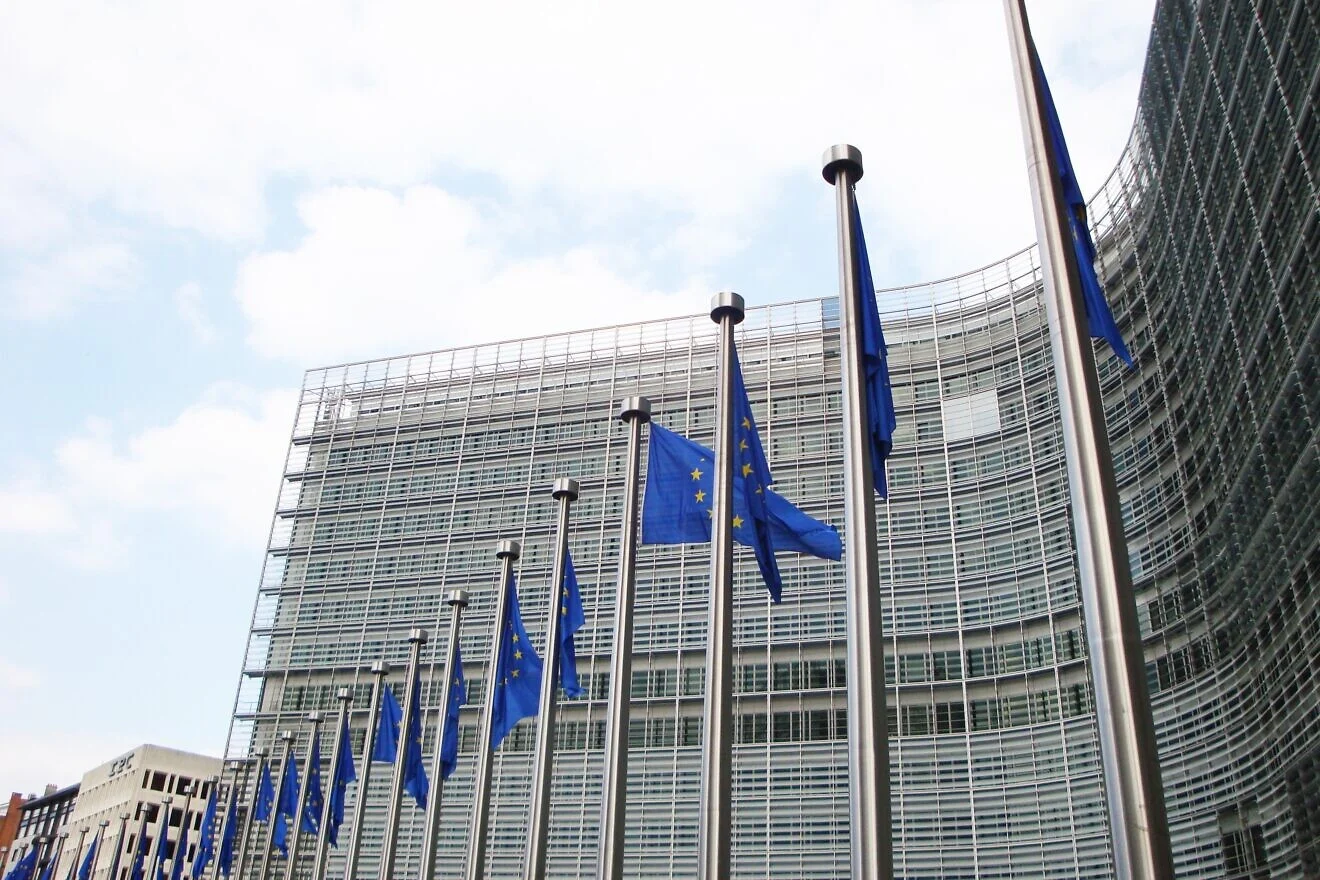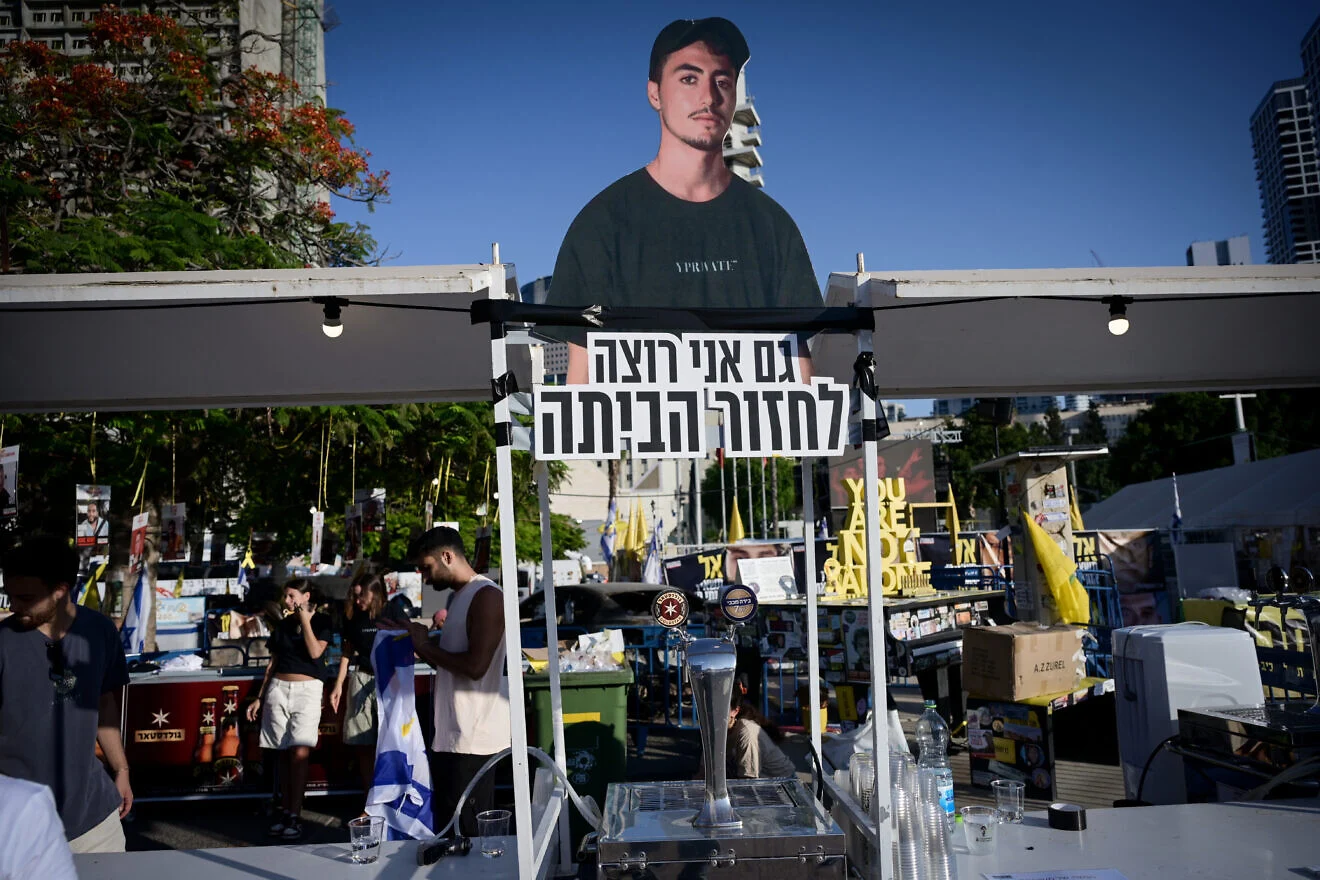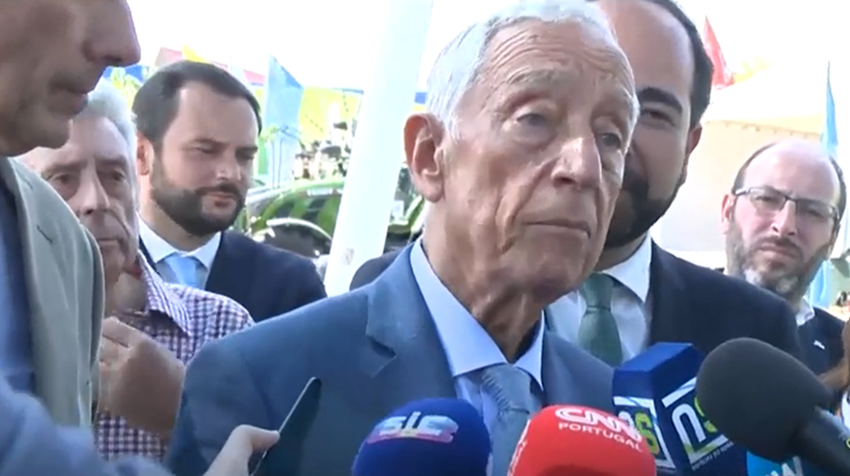Israeli Prime Minister Benjamin Netanyahu visited the IDF General Staff Reconnaissance Unit base in southern Israel on Oct. 17, 2023. Credit: Kobi Gideon/GPO.
When war broke out on Oct. 7, pundits around the world began asking whether the massive intelligence and security failure that led to the brutal murder of 1,400 Israelis, injury of thousands more and horrific kidnapping of as many as 240 hostages would be embattled Israeli Prime Minister Benjamin Netanyahu’s “Golda moment.”
Golda Meir was Israel’s prime minister when the Yom Kippur War broke out in October 1973, 50 years earlier to the day. The Israeli public never forgave her for failing to heed the intelligence warnings that war with Syria and Egypt was imminent. Months after the war’s conclusion and unable to form a majority coalition following in December 1973, Meir resigned in April 1974.
Does Bibi bear responsibility for Oct. 7?
The first and foremost responsibility of any Israeli prime minister is the security of its citizens. Netanyahu has maintained that he did not receive any security warning that an attack was impending and was only alerted at 6:29 a.m. on the morning of the infiltration by Hamas operatives over the southern border.
He has already acknowledged that there will be a full inquiry into the failings that led to the murderous assault on Israeli civilians. A recent attempt by Netanyahu to pin the failings on the security establishment in a tweet was met with harsh criticism. He quickly deleted the post.
In an interview Sunday with ABC News, he was pressed as to whether he would bear responsibility for the attack. He stated, “I’ve said that there are going to be very tough questions that are going to be asked, and I’m going to be among the first to answer them.”
Pressed further, Netanyahu correctly said that questions of responsibility are “going to be resolved after the war. I think there’ll be time to allocate that.”

Israelis watching a ceremony in memory of the victims who were murdered on Oct. 7 by Hamas terrorists and for Israelis abducted by Hamas terrorists in Gaza, at Habima Square in Tel Aviv, Nov. 7, 2023. Photo by Miriam Alster/Flash90.
Where was the IDF?
Aside from what took place in the days, weeks and months leading up to Oct. 7, there are numerous questions to be asked regarding conduct on the morning itself, which was Shabbat and the Jewish holiday of Simchat Torah. It took several of the longest hours in Israeli history for the Israel Defense Forces to reach many of the locations Hamas had penetrated along the Gaza envelope and to kill the thousands of perpetrators that broke through the Gaza border fence in numerous locations. Could the IDF have prevented hundreds of hostages from being taken into Hamas strongholds?
Conceptual failings
Furthermore, Netanyahu will likely be judged on Israel’s policy towards Gaza in all the years he has served as prime minister, in which continuous flare-ups and thousands of rockets were met by Israeli reprisals and eventual ceasefires. Each one enabled and empowered Hamas to rebuild and restock for future attacks, and was eventually broken with increasing frequency.
Netanyahu’s attempts to keep Israel out of a larger, more intensive conflict during repeated earlier outbursts of rockets and other violence—while appreciated by many at the time—did little to deter Hamas from launching the attacks on Oct. 7, and ultimately did little to keep Israel out of the larger war it is now engaged in.
The concept of Israeli deterrence proved to be little more than a smokescreen.
‘We are at war’
Yet questions regarding the run-up to the attack are different than ones regarding Netanyahu’s conduct since the war began.
From the moment that the scope of the Hamas attack was known, Netanyahu stated decisively that the current conflict was unlike previous rounds.
“We are at war. Not an ‘operation,’ not a ‘round,’ but a war,” he stated in a televised address on Oct. 7, in which he announced the full mobilization of the IDF, including 300,000 reservists. “The enemy will pay an unprecedented price,” he added, promising that Israel would “return fire of a magnitude that the enemy has not known.”
Diplomatic firestorm
And the world took notice. Since the war began, the diplomatic aptitude that Netanyahu is roundly respected for—even by his political foes—has been on full display.
Netanyahu drew immediate analogies between Hamas and ISIS (the Islamic State), the caliphate-driven terror entity that the United States had targeted militarily across the Middle East. He compared Oct. 7 to Sept. 11, which resulted in U.S. and allied military campaigns in Afghanistan, and later, Iraq. And he drew comparisons to the horrors perpetrated by the German Nazis during the Holocaust.
Recognizing that the international community would not remain silent observers as Israel pummeled the Gaza Strip and removed Hamas from power, Netanyahu understood that his only choice was to recruit and engage world leaders to recognize and support the justness of Israel’s cause, and to back its military campaign.
U.S. support
First and foremost, Netanyahu’s diplomatic campaign was to engage Israel’s most important ally: the United States. Since the war began, Netanyahu has hosted U.S. Secretary of State Antony Blinken four times. Israeli teams brought Blinken down to Israel’s south, where the atrocities took place, and showed photographs and video footage that left zero doubt as to the scope of Hamas’s barbarism. He also set up meetings with the families of hostages, including dozens of American citizens who were kidnapped.
U.S. Secretary of Defense Lloyd Austin arrived in Israel just days after he announced that Washington would deploy the USS Gerald R. Ford Carrier Strike Group. Several days later, Lloyd announced that the United States would also deploy a second CSG, the USS Dwight D. Eisenhower. The two carrier groups possess more air power than most countries’ militaries. They also have significant missile-defense systems that can protect Israel should Hezbollah start firing long-range missiles at Israeli population centers.
The deployments came along with an attempted message of deterrence for Hezbollah and Iran to stay out of the conflict.
Shortly after, U.S. President Joe Biden arrived for a quick visit and delivered one of the most pro-Israel speeches of his career.
In Jerusalem, Biden stated that “October 7th, which was a sacred Jewish holiday, became the deadliest day for the Jewish people since the Holocaust. It has brought to the surface painful memories and scars left by a millennia of antisemitism and the genocide of the Jewish people. The world watched then, it knew, and the world did nothing. We will not stand by and do nothing again. Not today, not tomorrow, not ever.”
Biden has pledged millions of dollars in supplementary military support for Israel’s war effort, including precision weapons and replenishments for Israel’s depleted Iron Dome air-defense system.
Leaders of the free world
Within two weeks of the Oct. 7 attack, Netanyahu had stood shoulder to shoulder with world leaders such as German Chancellor Olaf Schulz, British Prime Minister Rishi Sunak, French President Emmanuel Macron, Italian Prime Minister Giorgia Meloni, Romanian Prime Minister Marcel Ciolacu and Greek Prime Minister Kyriakos Mitsotakis. They displayed their nation’s flags next to Israeli flags, demonstrating to the world that they stand with Israel.
In each press conference with the world leaders, Netanyahu stated that Israel was at war, and that its campaign would be long and difficult. He made clear that the goal is to remove Hamas from political control over Gaza, as well as to ensure that Iran’s terror proxy would no longer have any military capability or motivation to carry out future attacks for decades to come.
Netanyahu also took a call with Russian President Vladimir Putin. While what was said in the call will most likely remain a mystery, a readout from the Prime Minister’s Office stated that Netanyahu “made it clear that Israel had been attacked by brutal and abhorrent murderers, had gone to war determined and united, and would not stop until it had destroyed Hamas’s military and governing capabilities.”
It’s difficult to imagine any other Israeli leader currently on the political scene handling these meetings.
Closing internal rifts
On the domestic front, Netanyahu worked quickly to strengthen his ruling coalition.
Prior to the war, Netanyahu had been ruling with a narrow and polarizing—albeit stable—right-wing coalition. A poorly rolled-out bid to make long-overdue, but highly controversial judicial reforms had divided and roiled the country. An already embattled Netanyahu was facing his worst domestic crisis. Internal divisions were characterized by mass protests, with warnings that Israeli Air Force pilots and military reservists would refuse to serve if called to active duty.
Those calls were suddenly put to the test and exposed as dangerous bluffs that may have led Hamas, Hezbollah and Iran to believe that Israel had been weakened by division, and thus susceptible to a major attack. And that Israel would lack the unity and resolve to fight back.
Taking on a war of this magnitude required quick action to demonstrate that fighting Israel’s enemies always trump secondary political calculations.
Emergency unity government
Netanyahu invited members of the opposition to join an emergency unity government. Former prime-ministerial challenger, defense minister and IDF Chief of Staff Benny Gantz heeded the call and joined into a unity alignment with his political rival, along with five members of his Blue and White Party, including fellow general and former IDF chief of staff Gadi Eizenkot, and former challenger within Netanyahu’s Likud Party Gideon Sa’ar.
It’s interesting to note that Netanyahu joined forces with more moderate opposition members and those with maximum security experience. His more extreme rivals were conveniently left out of the unity alignment. Progressive opposition leader Yair Lapid, who controversially transferred a significant natural-gas field in disputed waters over to Lebanon and attempted to convince Israelis that doing so would avoid a war with Hezbollah, was not asked to join.
Inner war cabinet
As part of the emergency coalition agreement, Netanyahu formed a five-member inner war cabinet that would be solely responsible for all major wartime decisions. The cabinet consisted of Netanyahu, Israeli Defense Minister Yoav Gallant, Gantz and Eizenkot.
Netanyahu also invited longtime confidante and Israel’s strongest diplomat, Strategic Affairs Minister Ron Dermer. Dermer recently served as Israel’s longtime ambassador to the United States. He is one of the chief architects of the Abraham Accords and had been tasked with three major responsibilities as strategic affairs minister: Israel’s relationship with the United States; expanding the regional circle of peace and negotiating a normalization agreement with Saudi Arabia; and working on efforts to prevent Iran from becoming a fully-weaponized nuclear power.

An Iron Dome air-defense system fires interception missiles as rockets fired from the Gaza Strip towards central Israel, as it seen from Moshav Yashresh on Nov. 7, 2023. Photo by Yossi Aloni/Flash90.
Delayed incursion
Immediately after forming the war cabinet, Israel began a significant air campaign to destroy military targets in the Gaza Strip. And it was announced that a ground incursion was imminent.
Yet days and days went by without troops entering the coastal enclave, and many in Israel began to wonder whether Israel’s leaders had the backbone to send Israeli troops—all sons (and, in some cases, daughters), brothers, fathers of families into a highly booby-trapped urban fighting environment.
The delay proved to be a masterstroke.
In the interim period, the IDF quickly ironed out the numerous logistics issues that accompanied Israel’s largest-ever military call-up. Troops were diverted both to Israel’s border with Gaza, as well as to the northern border with Lebanon, where Hezbollah poses an even larger military threat than Hamas does in the south. Intelligence was gathered as to the whereabouts of both hostages and Hamas leaders.
Battle plans were drawn, and commanders flown over the Gaza Strip in choppers to familiarize themselves with the battlefield. And both IDF conscripts and reservists—many of them who had not faced dangerous combat situations in years—received intensive urban fighting refresher training.
‘Move south’
Residents of the Gaza Strip were instructed via leaflets, phone calls and text messages to move to the southern end of the Gaza Strip. Hundreds of thousands have moved out of harm’s way, reducing the number of civilians that could get caught in the crossfire and lessening dangers for IDF soldiers.
Of course, Hamas has encouraged residents to stay put and has even set up roadblocks to prevent residents from moving along corridors to the south, which the IDF has repeatedly opened by force.
Meanwhile, the IDF has essentially laid siege to the northern Gaza Strip, making it difficult for residents and militants to stay.
Fully integrated attack
Since the ground troops entered the strip, Hamas’s designs of numerous Israeli casualties, which could likely take a toll on Israel’s willingness to continue fighting, have not been realized. Whether due to outstanding military planning, a few miracles or a combination of the two, soldiers have by and large managed to steer clear of the numerous booby traps laid by Hamas.
Rather than rush into large-scale direct combat, troops have moved strategically in and out of danger zones, demonstrating a fully integrated ground, naval and air attack. Small groups of soldiers that draw out terrorists from hiding places quickly communicate to the air force, which bombs the sources of fire.
High-tech and low-tech intelligence-gathering have provided detailed information on Hamas’s intricate tunnel network, which is being attacked from the ground and the air. In barely two weeks, the IDF has essentially conquered more than a quarter of the Gaza Strip and has fully encircled Gaza City.

Smoke rises during an exchange of fire between the Israel Defense Forces and Hezbollah on the border between Israel and Lebanon, Oct. 25, 2023. Photo by Ayal Margolin/Flash90.
A multi-front war …
While the primary arena of focus has been the Gaza Strip, Israel has been extremely active in other arenas as well. Israel is simultaneously fighting a simmering war with Hezbollah along Israel’s northern border. Hezbollah troop movements, anti-tank guided missiles, mortar and drone attacks have been met with significant IDF artillery and air reprisals.
While fighting continues to intensify, the IDF’s leveling of destruction in Gaza and two U.S. carrier groups have managed thus far to deter Hezbollah from entering full-scale conflict. Whether that deterrence will hold remains to be seen.
Air-defense systems, including Saudi and American air defenses, have been mobilized to shoot down ballistic missiles and drones fired from Yemen. The USS John Carney was reported to have shot down four ballistic missiles and 15 drones.
Israel has bombed Iranian targets, including terror proxy movements and weapons transfers in Syria. And it has been extremely active in arresting Hamas and other terror operatives across Judea and Samaria, more commonly known as the West Bank.
Amid a rise in terror attacks, the IDF must be prepared for full-scale, intifada-style violence and riots in mixed Arab and Israeli areas, both within and outside Israeli-controlled territory.
From victim to aggressor
While fighting is taking place, the initial widespread support that Israel received on Oct. 7 has been steadily waning. When Israel was brutally attacked, it was viewed as the victim and deserving of support. And yet within days, perceptions changed. The victim was now cast as the aggressor.
Mainstream media quickly pivoted from reporting on the carnage in Israel’s south to the carnage within Gaza. And the top concern broadcast across the globe is the number of Palestinian civilian casualties in the densely populated strip.

Israeli forces conducting ground operations in the Gaza Strip, Nov. 7, 2023. Credit: IDF.
How Israel fights ‘matters’
Netanyahu and his war cabinet understood from the moment the war began that maintaining American support throughout an extended military campaign would not be simple.
On Friday, Blinken—in his fourth trip to Israel—said: “I reiterated and made clear our support for Israel’s right to defend itself, indeed its obligation to defend itself.”
He added, “I’ve returned to the region to engage in intense diplomacy with our partners to try to help ensure that an attack like October 7th never happens again, and in doing so, that we forge a different future, a very different future, for Israelis and Palestinians alike; that out of this tragedy emerges a better tomorrow for both peoples and for the region.”
Yet Netanyahu’s team has taken increasing notice of Blinken’s tone following the initial statements of support. Since his very first visit, Blinken has been concerned with Israel’s methodology, strategy and tactics, as he is with an Israeli victory. “We’ve been clear that as Israel conducts its campaign to defeat Hamas, how it does so matters,” said Blinken, adding that “it matters because failure to do so plays into the hands of Hamas and other terror groups.”
Meanwhile, Israel has taken greater steps than any military in the history of warfare to reduce civilian casualties. It is likely that Israel’s conduct in this war will later be studied as the gold standard for protecting civilians in a war zone.
Humanitarian aid
As such, Netanyahu has taken decisions that otherwise might not be taken by any attacking country during a war. He has accepted American proposals to set up a “safe zone” in the southern Gaza Strip. Netanyahu has acceded to American requests to allow humanitarian aid to enter via the Rafah border crossing between Gaza and Egypt.
These decisions have been taken despite significant internal opposition, particularly in light of the ongoing hostage crisis, which is getting less and less attention in mainstream media. Families of hostages have demanded that Israel not allow a single morsel of humanitarian aid until their loved ones are returned.
While Israel has allowed aid to enter, it checks all deliveries on the Egyptian side of the border before trucks can enter Gaza. So far, approximately 200 trucks filled with food, water and medicine have been delivered to the southern strip. No aid has reached the northern strip, which provides additional incentive for residents to move south.
Netanyahu has refused to allow fuel to enter, despite American demands. Fuel is an essential component in maintaining the function of air-circulation mechanisms deep inside Hamas’s labyrinth of underground tunnels.

Trucks with humanitarian aid arrive in southern Gaza via the Rafah border crossing with Egypt on Nov. 2, 2023. Photo by Abed Rahim Khatib/Flash90.
Humanitarian pauses
The latest calls from Blinken and the Biden administration have been for “humanitarian pauses” to allow additional aid to flow and to potentially allow for the transfer of hostages. It is unclear whether the latter call is based on credible intelligence.
There is an increasing merger of the terms “humanitarian pause” and “temporary ceasefire.” Meanwhile, Netanyahu has rejected all calls for any ceasefire.
In the ABC interview on Monday, he stated, “There will be no ceasefire, general ceasefire, in Gaza without the release of our hostages. As far as tactical little pauses, an hour here, an hour there, we’ve had them before. I suppose we’ll check the circumstances in order to enable goods, humanitarian goods to come in, or our hostages, individual hostages to leave.
He added that any ceasefire will “hamper our effort to get our hostages out because the only thing that works on these criminals in Hamas is the military pressure that we’re exerting.”
Increasing U.S. pressure
While Biden is a member of the old Democrat guard that has seen Israel fight battles for its survival, including the 1973 Yom Kippur War, some key members of his administration are both younger and have less affinity towards the Jewish state. Many are holdovers from the presidency of Barack Obama.
When the war first broke out, Obama tweeted that “all Americans should be horrified and outraged by the brazen terrorist attacks on Israel and the slaughter of innocent civilians,” adding that America must “stand squarely alongside our ally, Israel, as it dismantles Hamas.”
Yet in a recent interview, the former president attempted to draw moral equivalence between Israel and Hamas, saying that “what Hamas did was horrific, and there is no justification for it. And what is also true is that the occupation, and what’s happening to Palestinians, is unbearable.”
It is believed in Israel that many members of the current administration share the views of their former boss and that many believe Obama still maintains influence over American policy.
Anonymous sources
Numerous articles in The New York Times, CNN and elsewhere are quoting anonymous administration officials, who suggest that Biden and his team are angered by Israeli war conduct.
A New York Times article claims that “U.S. officials told the Israelis that they could reduce civilian casualties if they improved how they targeted Hamas leaders, gathered more intelligence on Hamas command and control networks before launching strikes, used smaller bombs to collapse the tunnel network and employed their ground forces to separate civilian population centers from where the militants are concentrated.
Yet according to a Channel 13 Israeli television report, IDF Chief of Staff Herzi Halevi told Blinken during a meeting that adhering to the advice of American generals would cause “more casualties.” The report added that Halevi said that sending commandos into tunnels instead of bombing them from the air would essentially be “suicide missions” for Israeli soldiers.
Other anonymous sources suggest that Israel will not have an unlimited window to carry out its military campaign.
A CNN report claims that “behind the scenes, American officials also believe there is limited time for Israel to try to accomplish its stated objective of taking out Hamas in its current operation before uproar over the humanitarian suffering and civilian casualties—and calls for a ceasefire—reaches a tipping point.
“In fact, there is recognition within the administration that that moment may arrive quickly: Some of the president’s close advisers believe that there are only weeks, not months, until rebuffing the pressure on the US government to publicly call for a ceasefire becomes untenable, sources told CNN.”
Netanyahu and his war cabinet have pressed ahead with the campaign, despite mounting pressure.

Israeli Prime Minister Benjamin Netanyahu meets with U.S. Secretary of State Antony Blinken at the Kirya military headquarters in Tel Aviv on Nov. 3, 2023. Credit: Amos Ben-Gershom/GPO.
The day after Hamas?
Whether Blinken shares the same views as the anonymous sources is less certain, but he has made clear his belief that Israel must not remain in Gaza after the military campaign is finished. He added that the U.S. administration views the conflict as an opportunity to restart a failed peace process aimed at the formal creation of a Palestinian state.
In a meeting on Monday with Palestinian Authority chief Mahmoud Abbas, Blinken stressed America’s commitment “toward the realization of the Palestinians’ legitimate aspirations for the establishment of a Palestinian state.”
A recent Politico report asserted that during Biden’s brief visit to Israel, “The president pushed the prime minister to prioritize a two-state solution and be mindful of the steps beyond an effort to decapitate Hamas, including the challenges of any sort of future occupation of Gaza.”
The article sharply criticized Netanyahu, claiming that “Netanyahu hasn’t been a favorite of the Biden team. He was a loud supporter of former President Donald Trump, the Republican whom Biden defeated in the 2020 U.S. presidential election and may face again in 2024. And he was a sharp critic of the Iran nuclear deal the Obama-Biden administration helped craft. His increasingly hardline positions over the years have upset Biden aides who still support creating a Palestinian state.”
Yet Netanyahu told ABC that Israel has no intentions of leaving Gaza after the military campaign is complete. “Israel will, for an indefinite period will have the overall security responsibility because we’ve seen what happens when we don’t have it.
His comments fly in the face of U.S. thinking.
The day after Netanyahu?
According to Politico, “a current U.S. official and a former U.S. official both confirmed that the administration believes Netanyahu has limited time left in office.”
Successive U.S. administrations have put significant effort into trying to remove Netanyahu from office, as the prime minister documents in his recently published memoirs.
A political lifeline
But if the United States believes that having another Israeli prime minister in place would potentially fast-track a process towards facilitating the creation of a Palestinian state, they may be handing Netanyahu a sorely needed political lifeline.
Whether Israelis will ultimately hold Netanyahu accountable for the gross failures of Oct. 7 remains to be seen. But after what has happened in the Gaza Strip since Israel’s withdrawal in 2005, Hamas’s takeover in 2007 and constant fighting culminating with the Simchat Torah attack, Israelis are as certain as ever that a two-state solution is not a viable solution to the Israeli-Palestinian conflict.
And if Israelis believe that Netanyahu is who stands in the way of U.S. designs to push further land concessions on Israel, they may well keep their embattled prime minister in place for years to come.
For Netanyahu, a conclusive victory on the battlefield is critical to Israel’s future and his own political survival. Navigating through an enormity of considerations is a task that Netanyahu has been built for as Israel’s longest-serving prime minister.
How the war will end is still a question. The fighting is far from over, and many surprises are likely to develop in the coming days and weeks. As such, the final grade for Netanyahu’s handling of the conflict may not be handed down anytime soon.
Source: JNS



































